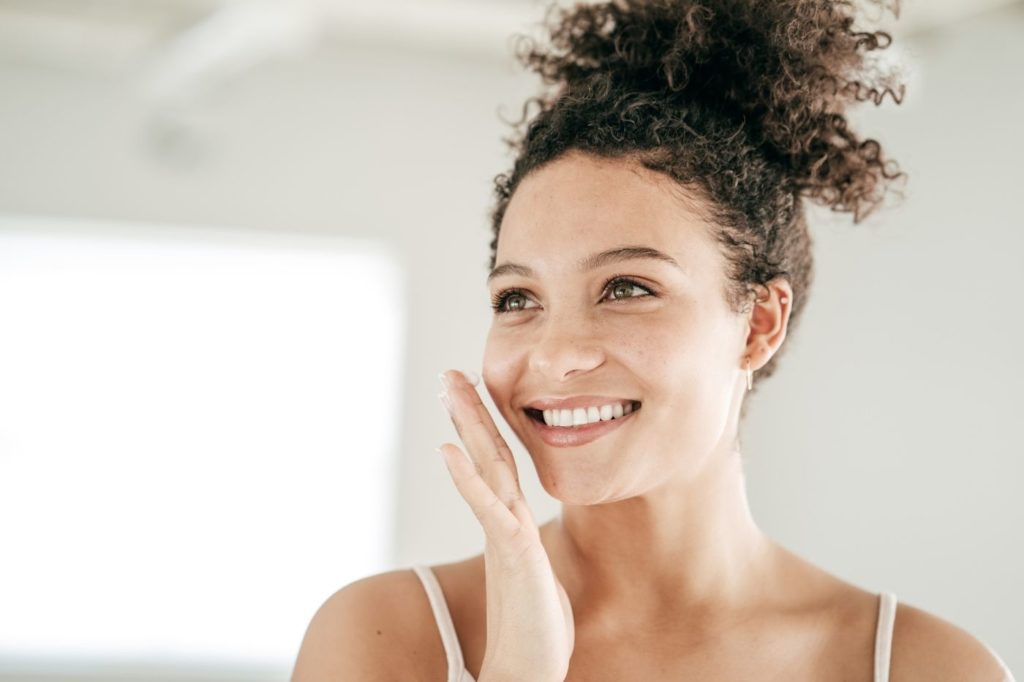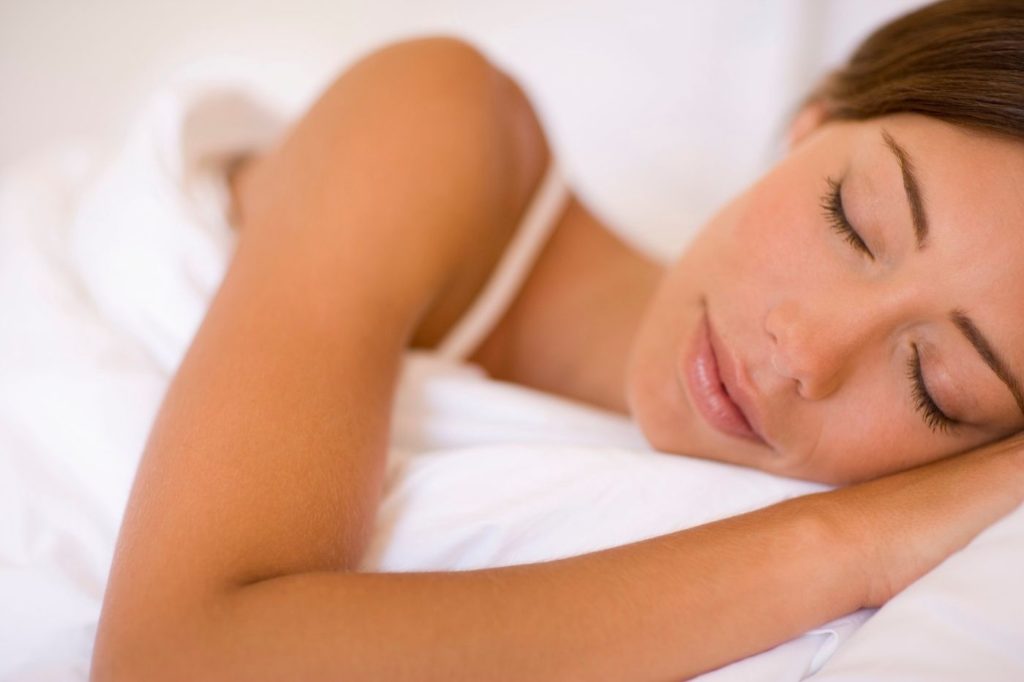
You may have heard of circadian rhythm before, but do you know what it is? Your circadian rhythm is the natural, internal process that governs many key bodily functions (including sleeping and waking) over a 24 hour period of time.
The circadian biological clock is controlled by the suprachiasmatic nucleus (found in the hypothalamus) and it responds to light and dark signals.
Did you know that the skin also has its own system which integrates with the rhythm of the day and/or season? It’s true! There is a circadian rhythm in cells of skin.
Based on your natural skin circadian rhythm, there’s even a good (and bad) time to apply certain skincare products. You can also do things to encourage a healthier skin circadian rhythm, which means the chances of a glowing complexion are actually in your reach.
Let’s take a closer look at how the skin’s clock works…
How Skin Cycles Follow Your Circadian Rhythm
As much as our skin may not seem active like other parts of the body, it’s actually always working and always changing on a daily basis.
According to a scientific article published in the Journal of Investigative Dermatology, our skin can even tell time. Within our skin, there’s a circadian clock that is always ticking. Pretty amazing, right?!
The researchers believe that the skin circadian rhythm, or the skin’s “clock”, is likely operating in most, if not all, skin cells, and “may influence the regulation of several circadian physiological phenomena, including cell proliferation.” Cell proliferation is another way of saying skin tissue growth.
A more recent scientific article published in 2019 highlights how cutaneous (skin) circadian rhythms influence not only cell proliferation, but also cell migration, wound healing, and damage control from things like ultraviolet radiation and oxidative stress.
Our skin (which is the largest organ of the human body) consists of several layers, but it’s the epidermal cells (top layer) which is in a constant state of change.
Some people say that human skin replaces itself every 35 days or so, but the skin cycle of cellular turnover of the epidermis actually slows down as we get older. In general, the skin cycle ranges between 14 days to 6 weeks.
This changeover of the epidermal layer can be negatively affected by a less-than-ideal circadian rhythm or a circadian rhythm disorder.
Your susceptibility to a circadian rhythm disorder or circadian variation increases with age. As I just mentioned, skin health can be negatively affected by a circadian rhythm disorder.
What causes a circadian rhythm disorder? In addition to older age, a circadian rhythm disorder can be caused by certain drugs, jet lag, poor sleep habits, lack of sunlight exposure for long amounts of time, and frequent changes in work shift.

The Body Clock
It’s often said that the skin is a mirror to what’s going on inside of the body. That said, it’s no surprise that the body clock has a direct impact on the skin and its inherent rhythm.
According to the CDC, the internal body clock sets the timing for many circadian rhythms, which regulate key processes like:
- Sleep and wake cycles
- Body temperature regulation
- Hormone activity
- Metabolic processes
- Eating and digestion
- Gene expression
Not so coincidentally, all of these processes can affect skin’s circadian rhythm, health, and appearance.
There’s also the Chinese body clock, which, according to traditional Chinese medicine, tells us how our qi (or energy) changes throughout the day and how specific organs are affected at different times.
Over a 24-hour period, qi is said to flow in two-hour time frames throughout the organs of the body. Waking at different times of the night are also said to be related to issues or imbalances within specific organs such as the liver or lungs.
Addressing issues highlighted by the Chinese body clock with organs that directly affect the health and appearance of the skin, such as the liver, can be another avenue for skin improvement.

What happens to your skin when you don’t get enough sleep?
What happens if your circadian rhythm is out of whack? When your circadian rhythm is disrupted, your skin may suffer in many ways, from minor irritations all the way to skin cancer.
According to a scientific review published in 2019, a disruption of circadian rhythm is behind many dermatologic conditions, including skin cancer.
One of the main ways that our circadian rhythm (of both our bodies and our skin) can get out of whack is a lack of sleep. The National Sleep Foundation recommends that adults get 7-9 hours of sleep per night.
Sleep provides your skin with much needed time to repair itself. While you’re sleeping, your skin is literally working overtime. As you count zzz’s, your skin goes into recovery mode – skin blood flow and skin temperature increases, collagen is produced, damage control from UV light/pollution takes place, and last but not least, DNA repair occurs.
Without proper rest, our skin doesn’t have a chance to properly repair itself from inflammation and damage. What does that physically look like? Not getting enough sleep can result in the following skin concerns:
- Breakdown of the skin barrier
- Loss of skin hydration
- Dry skin
- Suboptimal collagen production
- Poor wound healing
- Acne
- Premature skin aging (including development or worsening of wrinkles and fine lines)
- Dark circles under the eyes
- Age spots
- Increased risk of eczema and psoriasis
- General inflammation
Why The Time of Day Matters for Skin Care Products
Time of day affects whether or not a topical product is an ideal match for your skin or not.
A controlled study of healthy women finds that many skin variables are affected by the skin circadian rhythm. In fact, skin pH, skin temperature, sebum production, hydration, and transepidermal water loss all varied in a “circadian manner.”
Certain skin care products should be used at certain times of the day and certain topical products should not be used at certain times of the day.
How to Optimize Your Skin Care Routine
So, how do you know what products to use on your skin in the morning vs. before bed? For starters, antioxidants like vitamin C are best used in your morning routine to protect against free radical damage during the day from things like pollution and sun exposure.
Along with an antioxidant-rich product (likely also a product that supplies hydration), sunscreen, of course, should also be applied in the morning.
The main goal of your morning skin care routine is protection.
Retinol skincare products are always best used at night because they make the skin more sensitive to sunlight. Products with enzymes or acids such as glycolic acid should be used in the evening for this reason.
The evening is also when you want to use hydrating serums and creams with ingredients like hyaluronic acid to reduce water loss while you sleep.
The central goal of your night time skin care routine is repair and rejuvenation.

How to Get Better Sleep (for your skin!)
For the health of your skin, you can work on improving the quality of your sleep. It’s often referred to as “beauty sleep” for good reason! Aiming for some general homeostasis in your life is a great idea, too.
How do you restore my natural circadian rhythm? To restore your circadian rhythm, keep a consistent sleep schedule, limit your exposure to blue light, and try to reduce your stress levels.
First off, aim to be consistent with your sleep schedule so that you’re going to bed and waking up around the same times each day. When you keep your body in this expected routine, it helps to promote a healthy biological clock.
It’s also a great idea to limit your exposure to skin-damaging blue light throughout the day, but especially in the hours before you go to sleep. Indoor lights, computers, cellphones, tablets, televisions… these are all unnatural light sources that can throw off your circadian rhythm as well as your skin circadian rhythm.
Plus, disconnecting from your phone can actually help to prevent various diseases. Dimming the lights at night and avoiding the use of various devices helps to encourage sleep-inducing melatonin, and it’s also just a more relaxing pre-bedtime routine.
On the other hand, natural light emitted by the sun is something you want to expose yourself to in the early morning. By getting outdoors or letting natural sunlight into your home in the early morning, you can help to encourage a healthy sleep-wake cycle. It’s also a key way to feeling less groggy than usual, especially if you’re not a morning person.
Reducing stress and cortisol production also has a direct positive impact on the quality of your rest and on your skin health. I highly recommend trying Yoga Nidra, aka “sleeping yoga,” which can really help with sleep and cortisol reduction.
A good night’s sleep will literally show on your face. You’ll be so glad you shut your smartphone off a few hours before bed and took a nice relaxing bath instead. Bonus points if you do a face mask while you soak!
If you want to learn more about boosting your skin function and preventing skin aging from the inside out, check out: How to Achieve and Nurture Inner Beauty.
Sources
- Geyfman, M. & Andersen, B. (2009). How the Skin Can Tell Time. Journal of Investigative Dermatology, 129(5), 1063-1066. Full text: https://www.jidonline.org/article/S0022-202X(15)34341-4/fulltext
- Sherratt, M.J., Hopkinson, L., Naven, M., et al. (2019). Circadian rhythms in skin and other elastic tissues. Matrix Biology, 84, 97-110. Abstract: https://pubmed.ncbi.nlm.nih.gov/31422155/
- Cleveland Clinic. 2021. Circadian Rhythm Sleep Disorders. Retrieved from: https://my.clevelandclinic.org/health/diseases/12115-circadian-rhythm-disorders
- The Centers for Disease and Control and Prevention. 2021. Circadian Rhythms and Circadian Clock. Retrieved from: https://www.cdc.gov/niosh/emres/longhourstraining/clock.html
- Lyons, A.B., MD, Moy, L., MD, Moy, R., MD, & Rebecca Tung, R., MD. (2019). Circadian Rhythm and the Skin: A Review of the Literature. J Clin Aesthet Dermatol. 12(9), 42-45. Full text: https://www.ncbi.nlm.nih.gov/pmc/articles/PMC6777699/
- The National Sleep Foundation. 2021. Am I Getting Enough Sleep? Retrieved from: https://www.thensf.org/recommended-amount-of-sleep/
Le Fur, I., Reinberg, A., Lopez, S., Morizot, F., Mechkouri, M., & Tschachler, E. (2001). Analysis of Circadian and Ultradian Rhythms of Skin Surface Properties of Face and Forearm of Healthy Women. Journal of Investigative Dermatology. 117(3), 718-724. Full text: https://www.jidonline.org/article/S0022-202X(15)41371-5/fulltext
